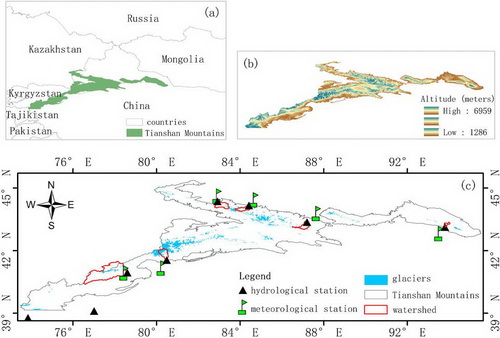Tianshan Mountains, known as the “Water Tower of Central Asia”, provide 40%-70% of the total river discharge in the mountains of Central Asia.
Due to the climate warming and precipitation change, glacial recession leads to changes of the downstream river flows of the Tianshan Mountains watershed at different time scales.
Therefore, the discharge and glacier mass balance (GMB) in the Tianshan Mountains are sensitive to changes in climate.
However, changes in the discharge and GMB in different glacierized catchments of the Tianshan Mountains under different changes in climate are poorly understood, and few comparative analyses have been performed.
Recently, the scientists from the Northwest Institute of Eco-Environment and Resources of Chinese Academy of Sciences analyzed the trends and periods of discharge and climate factors in six different glacierized watersheds of the Tianshan Mountains using non-parametric tests and wavelets.
In this study, on the basis of discharge and precipitation data, scientists reconstructed the GMB on the watershed scale by statistical mechanics and maximum entropy principle (SMMEO) model, and examined the discharge and GMB responses to climate change in different watersheds.
The results showed that regional climate warming was obvious, especially after 1996. The warming trend increased gradually from east to west, and the increase in temperature was greater on the north slope of the Tianshan Mountains than on the south slope.
Besides, the changing trends in precipitation increased from eastern region to central region, and then, the trend decreased in the western region, although the value was higher than that in the eastern region.
Therefore, significant periodicity indicated that the discharge in the different watersheds exhibited obviously different patterns. The GMB losses were larger in south and east than in north.
The large glaciers had more stable inter annual variations in discharge, and large fluctuations in discharge will be observed as the glacier areas shrink.
The results also indicated precipitation was the dominant factor for discharge during the study period, although the influence of increasing temperatures on hydrological regimes should not be neglected in the long term.
The aim of this study was to evaluate the fluctuations of glaciers and water resource changes on the watershed scale under changes in climate, which are of vital importance for water management in Central Asia.
This study has been published on the Hydrological Processes in an article entitled “Impacts of Climate Change on the Discharge and Glacier Mass Balance of the Different Glacierized Watersheds in the Tianshan Mountains, Central Asia”.

(a) Locations of the Tianshan Mountains, (b) distribution of altitude, and (c) hydro-meteorological stations in the watersheds
Contact
KANG Shichang
Email: shichang.kang@lzb.ac.cn
State Key Laboratory of Cryospheric Science, Northwest Institute of Eco-Environment and Resources, Chinese Academy of Sciences, Lanzhou, 730000, China.

